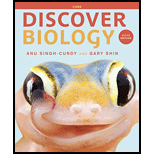
Concept explainers
Concept Introduction: Species are populations that can interbreed amongst themselves. Species can be Isolating mechanism act on the species. Isolating mechanisms shows that sometimes species cannot interbreed due to geographic barriers and that later lead to evolution.
Answer to Problem 1SQ
Correct answer: “Species that have overlapping geographic ranges but do not interbreed in nature are said to be reproductively isolated.” Therefore, option b. is correct
Explanation of Solution
Reasons for correct statement:
Reproductive isolations prevent the species that earlier interbred to interbreed again post reproductive isolating mechanism that is part of natural evolutionary mechanisms. Reproductive isolating mechanisms lead to
Option b. is given as “reproductively isolated”
As, species that have overlapping geographic ranges but do not interbreed in nature are said to be reproductively isolated, option b. is correct.
Reasons for the incorrect statements:
Option a. is given as “geographically isolated”.
In geographical isolation, the two species will not have overlapping geographical areas. So, option a. in incorrect.
Option c. is given as “influenced by genetic drift”.
Genetic drift occurs in small populations that are separated from the main population from which they migrated. So, option c. is incorrect.
Option d. is given as “hybrids”.
When two different species of the same genus that intra-breed they produce hybrids that are sterile. So, option d. is incorrect.
Hence, options a., c., and d. are incorrect.
Want to see more full solutions like this?
Chapter 15 Solutions
Discover Biology (Sixth Core Edition)
 Human Anatomy & Physiology (11th Edition)BiologyISBN:9780134580999Author:Elaine N. Marieb, Katja N. HoehnPublisher:PEARSON
Human Anatomy & Physiology (11th Edition)BiologyISBN:9780134580999Author:Elaine N. Marieb, Katja N. HoehnPublisher:PEARSON Biology 2eBiologyISBN:9781947172517Author:Matthew Douglas, Jung Choi, Mary Ann ClarkPublisher:OpenStax
Biology 2eBiologyISBN:9781947172517Author:Matthew Douglas, Jung Choi, Mary Ann ClarkPublisher:OpenStax Anatomy & PhysiologyBiologyISBN:9781259398629Author:McKinley, Michael P., O'loughlin, Valerie Dean, Bidle, Theresa StouterPublisher:Mcgraw Hill Education,
Anatomy & PhysiologyBiologyISBN:9781259398629Author:McKinley, Michael P., O'loughlin, Valerie Dean, Bidle, Theresa StouterPublisher:Mcgraw Hill Education, Molecular Biology of the Cell (Sixth Edition)BiologyISBN:9780815344322Author:Bruce Alberts, Alexander D. Johnson, Julian Lewis, David Morgan, Martin Raff, Keith Roberts, Peter WalterPublisher:W. W. Norton & Company
Molecular Biology of the Cell (Sixth Edition)BiologyISBN:9780815344322Author:Bruce Alberts, Alexander D. Johnson, Julian Lewis, David Morgan, Martin Raff, Keith Roberts, Peter WalterPublisher:W. W. Norton & Company Laboratory Manual For Human Anatomy & PhysiologyBiologyISBN:9781260159363Author:Martin, Terry R., Prentice-craver, CynthiaPublisher:McGraw-Hill Publishing Co.
Laboratory Manual For Human Anatomy & PhysiologyBiologyISBN:9781260159363Author:Martin, Terry R., Prentice-craver, CynthiaPublisher:McGraw-Hill Publishing Co. Inquiry Into Life (16th Edition)BiologyISBN:9781260231700Author:Sylvia S. Mader, Michael WindelspechtPublisher:McGraw Hill Education
Inquiry Into Life (16th Edition)BiologyISBN:9781260231700Author:Sylvia S. Mader, Michael WindelspechtPublisher:McGraw Hill Education





